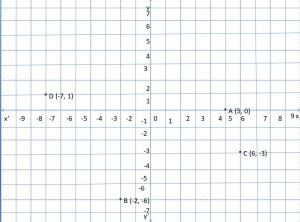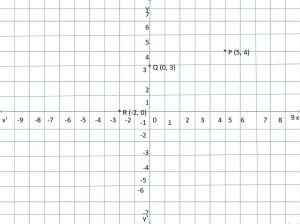Ordered pairs are used to locate a point on a cartesian plane. It has parenthesis, a comma, and two real numbers. The first real number is called the x coordinate or abscissa, and the second one is known as the y coordinate or ordinate. Those numbers can be either positive or negative. Depending on the sign of the coordinates, you can say that point belongs to which quadrant.
On this page, we are providing useful information like how do you define an ordered pair, steps of plotting ordered pairs on a coordinate plane, the detailed procedure to identify the quadrant of ordered pairs.
Ordered Pair Definition
The ordered pair is nothing but a point in the two-dimensional coordinate plane. It is used to locate a point on the graph. Every ordered pair has two coordinates namely abscissa and ordinate.
How do you plot an ordered pair of points on a Cartesian plane?
The following are simple and easy steps to locate a point in a cartesian plane. Check out the guidelines, terms, and conditions to plot ordered pairs.
- Let us take one ordered pair.
- Get the sign of x coordinate, y coordinate of the ordered pair.
- Based on those signs, identify which quadrant the ordered pair belongs to.
- Count x coordinate value on the x-axis starting from the origin.
- Similarly, count the y coordinate value on the y-axis from the origin.
- Mark the obtained point as the ordered pair.
Solved Example Questions
Example 1.
Plot P (4, 1) on the graph?
Solution:
Given point P (4, 1)
The x coordinate of the point is positive, 4. While the y coordinate is also positive, 1.
So, both the coordinates are positive, the point P belongs to the first quadrant.
To locate this point P, measure 4 units on the x-axis from the origin (towards the right). And count 1 unit on the y-axis from the origin (towards up). Draw a line from 4 and 1, the point those lines meet is called the ordered pair P(4, 1).

Example 2.
Plot the following ordered pairs in one coordinate plane.
a. A (5, 0) b. B (-2, -6) c. C (6, -3) d. D (7, -1)
Solution:
Given ordered pairs are A (5, 0), B (-2, -6), C (6, -3), D (-7, 1)
The abscissa for A is 5, the ordinate is 0, both are positive. Therefore this ordered pair lies in the first quadrant. Take 5 units on the x-axis (towards the right) and 0 units on the y-axis and mark the point with strict or any other symbol.
The x coordinate is -2, the y coordinate is -6, both are negative. So, point B lies in the third quadrant. Measure 2 units from the origin on the x-axis (towards left), 6 units on the y-axis (downwards). Mark that particular point as B (-2, -6).
For the ordered pair C (6, -3), the x coordinate is positive and the y coordinate is negative. Then, the point lies in the fourth quadrant. To represent the ordered pair on the coordinate graph, you need to draw horizontal lines naming XOX’, YOY”. Count 6 units on the x-axis towards the right from the origin and count 3 units on the y-axis towards from the origin. Plot that point on the graph as C.
The abscissa for point D is -7 and negative and ordinate is positive and 1. You can say that the point lies in the second quadrant. At first, draw one horizontal line (x-axis), vertical line (y-axis) meet at origin O. Write down the numbers as a coordinate graph. Now, measure 7 units on the axis towards the left from the origin, 1 unit on the y-axis towards up.

Example 3.
Plot the below given three points on the graph?
a. P (5, 4) b. Q (0, 3) c. R (-2, 0)
Solution:
Given ordered pairs are P (5, 4), Q (0, 3), R (-2, 0)
First point P (5, 4) is 5 units away from the origin on the x-axis, 4 units on the y-axis. As coordinates of the point are positive, it lies in the first quadrant.
As the second point has the x coordinate is zero, the point available on the y-axis and 3 units away from the origin. It also lies in quadrant 1.
In the same way, the third point also contains the y coordinate is zero, it is present on the x-axis. And its x coordinate is negative, so it lies in the third quadrant.
